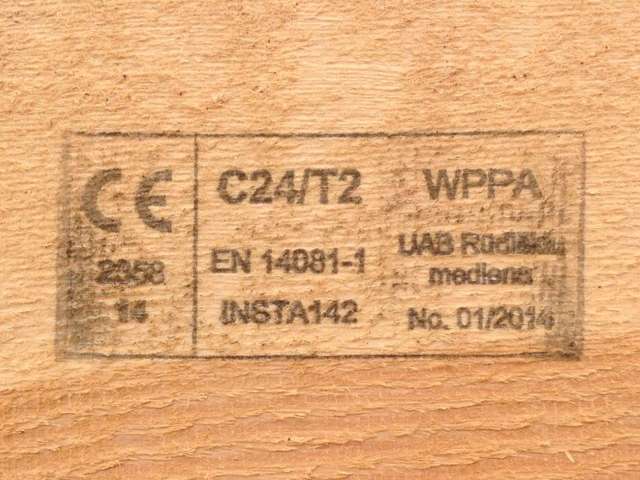Our company is certified to perform timber strength grading in accordance with a standard BS EN 14081-1:2005.
The standard defines several standardized timber strength grades and specifies their minimal physical characteristics; for instance, C14, or a stronger one – C24 grade. Those C-grades are used all across the European Union.
Our trained specialist is certified to perform visual strength grading in accordance with INSTA142 and assign it these grades: C14, C18, C24, and C30.
A common use for strength graded timber are load bearing constructions. When timber is going to be put under consistent and high load, predictable strength is of utmost importance.
Timber strength depends on many factors, thus even identically sized planks can have wildly varying strength characteristics. In order to ensure safety and adherence to standards, it is recommended to evaluate strength characteristics of construction timber.
During visual strength grading every piece is evaluated on a list of grading criteria. Some examples are: number of knots, their positions and sizes, wood grain abnormalities (angle relative to the longitudinal axis), cracks, and other.
Every piece of timber that passes the checks is marked with a stamp specifying the standard BS EN 14081-1:2005, the issuing body (us) and their ID, wood type, and a respective strength grade.

Timber strength class characteristics
| Wood class | Strength properties (in N/mm²) | Stiffness properties (in kN/mm²) | Characteristic density (in kg/m³) | Average density (in kg/m³) | ||||||||
| Bending | Tension, parallel | Tension, perpend. | Compression, parallel | Compression, perpend. | Shear | Mean modulus of elast., parallel | 5% modulus of elast., parallel | Mean modulus of elast., perpend. | Mean shear modulus | |||
| C14 | 14 | 8 | 0.4 | 16 | 2 | 3 | 7 | 4.7 | 0.23 | 0.44 | 290 | 350 |
| C18 | 18 | 11 | 0.4 | 18 | 2.2 | 3.4 | 9 | 6 | 0.3 | 0.56 | 320 | 380 |
| C24 | 24 | 14 | 0.4 | 21 | 2.5 | 4 | 11 | 7.4 | 0.37 | 0.69 | 350 | 420 |
| C30 | 30 | 18 | 0.4 | 23 | 2.7 | 4 | 12 | 8 | 0.4 | 0.75 | 380 | 460 |
